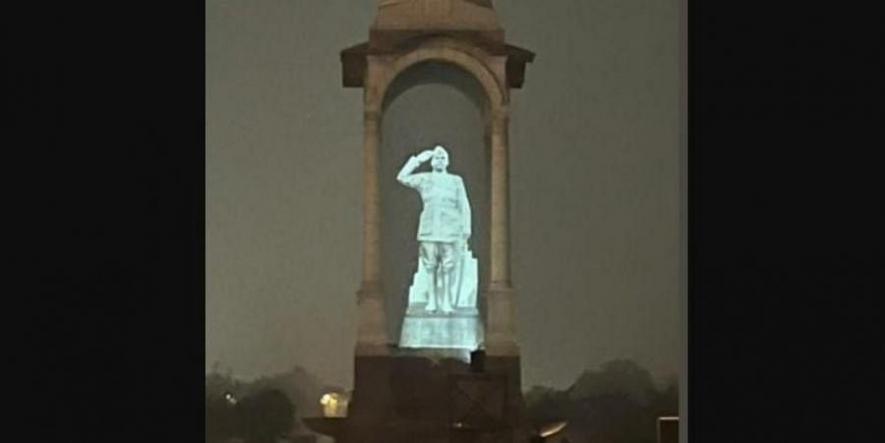To Modi Government, Netaji is Just a Hologram

Image Courtesy: Twitter@narendramodi
Every year, this is the time when the Modi government and BJP have a serious problem. The BJP’s claim of being a nationalist party flounders against the brutal reality of having almost no leader of stature that stood up to the British in India’s freedom struggle. That is why it attempts to appropriate any leader, even if they belong to other political streams. It started with Sardar Patel and the Statue of Unity; it continued with Dr BR Ambedkar on his 125th birth anniversary; now, it is the turn of Netaji Subhas Chandra Bose.
Of course, the BJP can legitimately claim Savarkar. Even if Savarkar, after an initial history of struggle against the British, tarnished his reputation by writing letters during imprisonment vowing allegiance to the Raj. But how much can you flog one sole nationalist icon against a pantheon of the figures that any other stream in the national movement can muster—from the Congress to the Socialists, the Communists, the Dravidian and Dalit movements? The problem for the BJP is worse; they do not only have to invent a past in the national movement that they simply do not have. They also have to appropriate these icons despite their publicly expressed contempt in speeches and writings about the RSS and the Hindu Mahasabha (the Jana Sangh only came to exist in 1951 after Gandhi’s assassination). These views were not one-sided; Ambedkar and his steering of the Indian Constitution were eyed with deep hatred by the RSS, who wanted it to be derived from the Manusmriti as recorded in the 30 November 1949 issue of The Organiser.
Modi has always believed that pomp and show can overcome the flimsy basis of his claims. That is why the majestic, enormous Statue of Unity came at around Rs. 3,000 crore expense. Something that the Sardar would have found completely wasteful. The statue’s size is to cover up for Patel being a lifelong Congress leader instrumental in banning the RSS after Gandhi’s assassination.
This time, Netaji seems to be an afterthought: not even a statue, only a hologram! Missing the statue, Modi resorted to a gimmick—copied from his election campaigns—of a holographic image of Netaji’s sculpture. All the hologram did was show up the event for what it was: an attempt to appropriate a leader who had a deep contempt for the vision and leaders of the RSS.
The one legacy of Netaji in India’s freedom struggle was the formation of the Planning Committee when he was the president of the Congress party. The physicist Meghnad Saha, who was close to the communists, had worked with Bose to set up this committee. Bose asked Nehru, also a fellow socialist, to head this committee. The Planning Committee Bose formed in 1938 after independence became the Planning Commission.
One of the first acts of the Modi government—announced "appropriately" in his first Republic Day speech as Prime Minister—was to dismantle the Planning Commission and replace it with the toothless and vacuous Niti Aayog. So he has dismantled the true legacy of Bose with his holographic image: a game of light and shadows without any substance. This game is increasingly becoming the Modi government’s true legacy!
Ambedkar, speaking to the Constituent Assembly, emphasised that democracy encompassed both the social and economic spheres. In fact, all three—Bose, Nehru and Ambedkar—made clear that they drew their inspiration of socialist society from the Soviet Union, even if they disagreed with communism. Bose saw the planning and building of a public sector as an absolute necessity for India’s industrial and agricultural regeneration. He also saw it as an instrument to redistribute the benefits of development to all sections of society. It is only by state intervention in the economy that he felt an independent India would be able to free India from the absolute poverty, famine, abysmal life expectancy and illiteracy that the British colonial rule had imposed on India.
People with no history in the national movement forget the state that two centuries of British rule had left India in. It had completely destroyed Indian industry, made India an importer of almost all advanced industrial goods, tied its economy to the British.
To break free from the stranglehold of the British, India had to do three things. It needed to plan its economic resources; the state needed to build the heavy-industries sector; it had to raise the critical human resources required in any national development by investing in education and research. This was the vision that Bose set up and placed in his Presidential Address to the Haripura Congress in March 1938. This vision of the planning and industrialisation of India is what he repeated in August the same year in his interaction with Meghnad Saha. Both are available as documents published by the Planning Commission in 1997 under Madhu Dandavate as Vice-Chairman, in a publication titled Subhas Chandra: Pioneer of Indian Planning. This was the common vision that Saha, Bose and Nehru shared of planning and industrialisation of India. They drew their inspiration from the Soviet experiments with planned development after the October Revolution. Saha fell out with Nehru later on his compromise with British and big Indian capital and was elected to the Indian Parliament with the support of the Communist Party.
For those who want to dismiss India’s achievement in its initial years and minimise the role of the British in de-industrialising India, here are some figures. Mughal India was about 25-30% of the global economy (Angus Maddison's estimates). No, India’s economic share in the global economy did not fall with the Muslim rule as the RSS, Modi and others in the BJP would have us believe. It fell only with the British colonial rule, from 25-30% to about 7-8% of the global economy. This decline accompanied 80% of people living below the poverty line, a life expectancy of 32 years and people prey to repeated famines. With independence and the Five-Year Plans, India went from importing 90% of industrial goods in 1947 to half that in 1960, and only 9% by 1974. Life expectancy rose from 32 to about 50 years in this period.
Contrast this with the vision of the RSS. In any of their writings, there is no mention of the Indian economy, the key issue before the independence movement. For Golwalkar and his colleagues, the fight was against not the British but the Muslims and the secularists in their efforts to create a Hindu India. As we have written earlier, when Golwalkar defines the nation—We or Our Nationhood Defined—he talks about land, race, religion, culture and language, never the economy. In his concept of the nation, economic freedom and foreign capital controlling the Indian economy were non-issues.
Not surprisingly, the RSS was quite happy with the role of British capital. It railed against the policies of independent India that made developing an independent economy a core task of the state. For them, planning was hated socialism, and that is why after Modi won, his first major task was to dismantle the Planning Commission, the legacy as much of Bose as Nehru. That is why the BJP government believes we can import technology without the need to develop it here. Foreign capital will develop India, with the Indian state needing to do nothing but make land and labour available to it cheaply.
This is the vision of the Modi government, which believes in Bose as a hologram or, at best, a statue. That is why we are now headed from self-reliance, the goal of the independence movement, to a future with only Reliance and other crony capitalists of the party in power. That is why we see the share of the top 10% in India of the total national income grow to 57%, while the share of the bottom 50% has fallen to 13% (Oxfam's World Inequality Report, 2022). This is Modi’s India, where light and shadows replace reality.
Get the latest reports & analysis with people's perspective on Protests, movements & deep analytical videos, discussions of the current affairs in your Telegram app. Subscribe to NewsClick's Telegram channel & get Real-Time updates on stories, as they get published on our website.
























